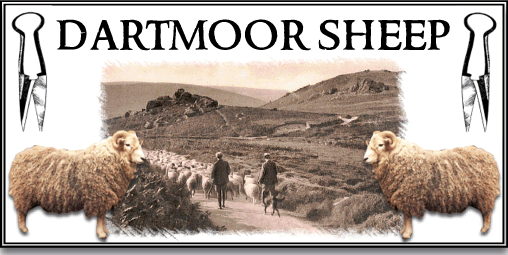
It is thought that sheep have been a part of the Dartmoor landscape since prehistoric times, in fact some say that the native Dartmoor breeds were descended from the Iron Age Soay sheep. There is certainly evidence that by the late 13th century Dartmoor was a wool producing area. Around about 1190, Buckfast Abbey received a charter from Richard 1 which confirmed that the monks in, “all their lands and tenements”, and he also gave them permission to pasture their sheep and cattle on the moor throughout the year. In a cartulary of Buckfast abbey the following appears:
“The Abbot and the monks of Buckfast, always up to the time of the first plague (1348-9) kept, on the moor of Buckfast, a lay-brother, one succeeding another without interruption, living in a house on Buckfast Moor, and to guide about and shut in at night the said cattle (and sheep) within an enclosure of a hundred acres adjoining the said dwelling. The last of the lay brothers who lived in said dwelling was Brother Henry Walbrook, and the walls and ditches of the said house and enclosure are still to be seen…“.
Sadly, today this is not the case as the above mentioned house and enclosure lie under the Avon reservoir and can only be seen in years of severe drought. The house was excavated in 1954 by Aileen Fox who came to the conclusion that it could be confidentially identified with the Buckfast Abbey lay-brother’s house. It is known that by the 14th century the Cistercian abbey at Buckfast was listed in a document of suppliers to the Florentine wool traders. Buckland Abbey was another Cistercian house which also kept sheep upon Dartmoor.
By the late 16th century it is estimated, from Camden, that every summer near to 100,000 sheep were pastured on the moor. In 1793, Risdon’s Survey estimated that there were between 110 -112,000 sheep grazing upon Dartmoor. By 1797 this figure had dropped to around 80,000 which was attributed to the improvers enclosing the commons. The decreasing trend continued and by 1811 the numbers of sheep had fallen to around 50 – 60,000 and in 1808 Vancouver estimated that:
“... in the month of October last, there were estimated by gentlemen residing in the neighbourhood (Widecombe-in-the Moor), to be no less than 14,000 sheep (on the parish commons)“.
Ministry of Agricultural figures stated that in 1939 there were 108,000 sheep in all of the Dartmoor parishes, this figure declined further to 98,000 by 1949 of which around 30,117 were on the moor. Figures taken from the Agricultural and Horticultural MAFF/DEFRA census show that the sheep numbers on Dartmoor farms rose from around 56,000 in 1972 to over 200,000 in 2002. This huge increase was due to the Common Agricultural Policies sheep regime. Today there are 145,000 sheep grazing rights on the commons which would be a close reflection of the early figures.
So how was the moorland sheep grazing managed/ In 1808, Vancouver made the following remarks:
“From the number of sheep annually summered upon Dartmoor, the ewes and lambs of which were always brought down into the country on the approach of winter, it will be readily supposed, that a large proportion of sheep stock is always found to occupy the surrounding districts during the winter season. The greater part of these flocks, however, being wethers (a male sheep castrated as a lamb), and chiefly preserved for their wool, are left upon the forest during winter. These mostly belong to persons residing in various parts of the country, are often changing their owners, by which it should seem that the flocks, and not the proprietors, possess the rights of pasturage on the forest. This right, doubtless originated with a tenancy in venville, and a flock of any number growing upon such a right, seems to continue, and their owners to possess it exclusively, as their attendants on every occasion never cease to dog-off, and chase from the respective sheep walks“.
He further added:
“The broken mouthed sheep are culled out at shearing time, at which period these old sheep are usually in very good condition, when they are either fattened at home or disposed of for that purpose. The Dartmoor wether at five years of old will average about 16lbs (7.2kg) per quarter, and produce from 4½ – 6½ lbs (2 – 3 kg) of unwashed wool. The ewes and lambs, with the preceding years hog sheep (a sheep up the the age of 1 year and yet to be shorn), are brought down from the forest in the beginning of November; in some cases the lambs are not returned with the ewes to the forest after shearing, but weaned at home in the enclosures, and upon the lower moors and commons in the country… The usual consideration paid to those who rent the different quarters of the Forest of Dartmoor directly from His Royal Highness the Prince of Wales, is 3s 4d per score, annually; a sum considered sufficient to exempt them from all liability of having their sheep impounded or taken up as estrays. “
There are two native breeds of sheep bearing the name Dartmoor – the White Face and the Greyface. Both are descendants of the native heath sheep, which grazed Dartmoor in the seventeenth and eighteenth centuries. Both types were popular around Dartmoor but changing market demands led to their decline from the 1940s onwards. In 1808, Charles Vancouver wrote:
“The Dartmoor breed are those most commonly met with. The reason stated for this variety is, that the Dartmoor, being at home, are more inured to the climate, are good nurses, and although they do not feed so quick, when put to good keeping, when put to fat, they always prove the very best of mutton, and never fail commanding a superior price“.
In 1832, Eliza Bray gave the following description of the Dartmoor Sheep:
“The Dartmoor sheep which produces the well known Oakhampton mutton, is a small breed weighing about fourteen pounds per quarter. They are kept on the moor during the summer, and the cheapness of their feed which amounts to twenty pence a score for that season, and from seven to nine pence for the winter, makes it profitable to the farmer to keep large flocks of them principally for the sake of their wool, which averages seven pounds a fleece. Their superior flavour may be ascribed principally to the nature of the animal, and partly to the circumstance of their being killed at a more mature age than is usual in other places:- by no means can it be attributed to the herbage of the moor, which is exceedingly coarse and deficient in nourishment“.
In 1997 there were 1,800 Greyface breeding ewes and 2,000 whiteface breeding females. However, since that survey the Dartmoor breed was badly effected in the 2001 Foot and Mouth epidemic.
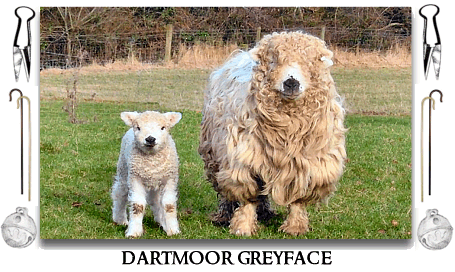
Photograph – Devon Sheep Breeders Association
Greyfaces are sometimes referred to as the ‘Improved Dartmoor’ because in the 19th century they were crossbred with Nottinghamshire and Leicester longwools. The actual sheep is of medium size, weighing around 60kg. They are hornless, deep bodied and short legged with densely woolled hind legs and head. Each sheep averages a clip of between 7 and 7 kg with rams returning up to 15kg. The fleece is classified as ‘Lustre Longwool’ and was used in the manufacture of blankets, carpets, cloth and serge. As mothers the Greyface ewes are considered docile and good rearers with excellent milk yields which are easily capable of rearing twins. This breed was known for its ability to survive and reproduce in adverse weather conditions and was the best suited breed to utilise hill and mountain grazing. It is said that after September you can taste the moorland sweetness in the lamb meat.
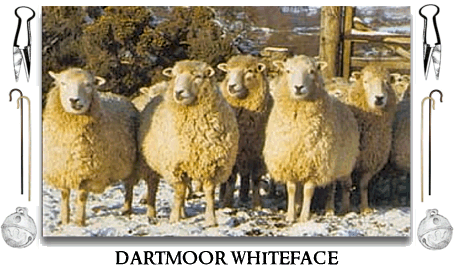
Photograph – Sheep R Us
The Whiteface Dartmoor breed is thought to be one of England’s older breeds which at one time was to be found in many parts of the Westcountry. Characteristically they have a white head and face which in the ewes is typically wool-free. Their breast is deep and prominent with a good strong neck and large shoulders. The body is considered to be of medium length and both deep and broad, typically the rams are horned Like the Greyface this breed is ideally suited to the moorland conditions and has a great ability to withstand both wet and cold winters without any lamb crop or wool losses. On average a wool clip for a ewe with yield between 5 and 7kg.
The ewes have a strong mothering instinct with high milking ability and usually return a lambing percentage of about 150%. Over the past century and a half the breed has been used to improve other long wool breeds such as the Welsh Mountain sheep.
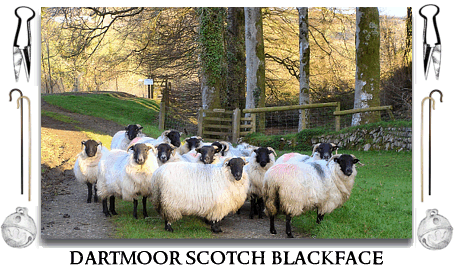
Today, by far the most common breed of sheep to be seen on the moor is the Scotch Blackface. There is some discussion as to who first introduced the breed as William Crossing in his book, ‘The Dartmoor Worker’, mentions that:
“More than twenty years ago (1883ish) Mr Lamb came to reside at Prince Hall, and introduced Scotch sheep on Dartmoor… His death prevented the accomplishment of his plans, but he achieved sufficient to prove that the breed was well adapted to the climate of Dartmoor“.
However in his book ‘A Hundred Years on Dartmoor’ he writes the following:
“The ruins of a large enclosure, covering about three quarters of an acre, and known as the Sheepfold, may be seen near Hartland Tor, on the East Dart. It was built by a Scotchman, who engaged extensively in sheep farming on the Moor, and was admirably adapted to its purpose. It was burned down a few years prior to 1830… In more recent years the late Mr Lamb took Prince Hall and other properties on the Moor, and devoted his attention to the rearing of Scotch Sheep“.
Ok, no problem, just because a Scotchman built a sheepfold he did not necessarily breed Scotch sheep, but then in his book ‘Crossing’s Guide to Dartmoor’ the author states the following when discussing the same sheepfold:
“The place was built by a Scotchman for the purpose of folding Scotch sheep, and was burnt down between 1820 and 1830“.
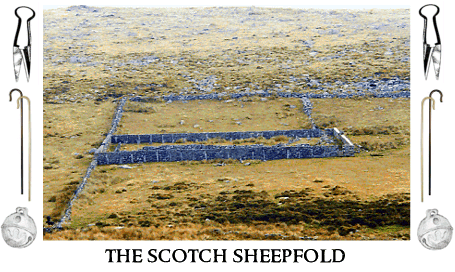
So from all that we can establish that the latest the Scotch sheep appeared on the moor was in the 1880’s and that they were either introduced by a nameless Scotchman or Mr Lamb, the latter sound more appropriate. However, there is another suggestion that the Scotch Blackface was introduced to Dartmoor by a Mr Gemmell of Teignhead Farm. Either way come to Dartmoor they did where they have thrived ever since as can be seen from the photo below of some 2006 lambs, which oddly enough was taken not far from Mr Lamb’s farm at Prince Hall. If it had not been for ‘Foot and Mouth’ they may even have been the descendants from the original flock?
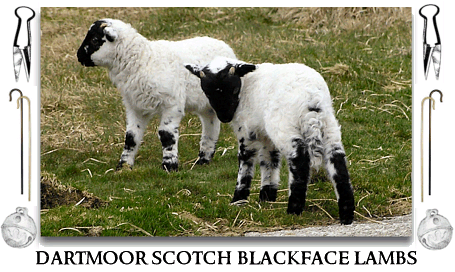
Not only have sheep been an ever present part of the Dartmoor landscape many of the place-names reflect their importance. The list below contains but a few examples of ovine related place-names, as always what name we have today did not originally necessarily have the same connotation, ie Sheepstor was in 1168 was Sitelestorra, the Siteles element meaning either a personal name or ‘bar’.
| Name | OS Grid ref. | Description |
| DIP TROUGH GATE | SX 6258 6142 | Gate |
| FLOCK O’ SHEEP | SX 628 907 | Rocks |
| GREY WETHER, THE | SX 7115 7868 | Bound Stone |
| GREY WETHERS | SX 6045 7768 | A clitter slope |
| GREY WETHERS, THE (NORTH) | SX 6389 8318 | Stone Circle |
| GREY WETHERS, THE (SOUTH) | SX 6389 8313 | Stone Circle |
| LAMBHOLE WOOD | SX 505 842 | Wood |
| LAMBS DOWN | SX 695 662 | Down |
| LEG O’ MUTTON CORNER | SX 5177 6790 | Corner |
| RAMS PARLOUR, THE | SX 7101 7146 | Natural cave |
| RAMSHORN DOWN | SX 793 739 | Down |
| RAMSLEY HILL | SX 6510 9300 | Hill |
| REDAVEN SHEEP DIP | SX 6250 6135 | Old sheep dip |
| REDDAWAY’S SHEEPWASH | SX 6218 9249 | Old Sheepwash |
| SHEEP MEASURE, THE | SX 6526 7558 | Enclosure |
| SHEEP PATH, THE | SX 5305 8510 | Trackway |
| SHEEPFOLD CORNER | SX 6230 7090 | Corner |
| SHEEPFOLD, THE | SX 6448 8090 | Enclosure |
| SHEEPS TOR | SX 566 682 | Tor |
| SHEEPSTOR | SX 559 676 | Village |
| WASH FIELD | SX 72?? 81?? | Enclosure |
| WASH GATE | SX 6937 6140 | Gate |
| WASH, THE | SX 72 81 | Enclosure |
| WASHING PLACE, THE | SX 6504 9325 | Sheepwash |
As can be inferred from the above list there are a lot of features associated with sheep management on the moor. Many of these were of a granite construction and so in some cases remain in-situ today.
‘Dip Trough Gate’, ‘Redaven Sheep Dip’, Reddaway’s Sheepwash’, ‘The Washing Place’, etc all refer to places near rivers or streams where the sheep were ‘washed’ or in later years ‘dipped’. Marshall noted that in Devon and Cornwall the regime of sheep washing was unique for here the sheep were shorn before they were washed. One possibility for this was that clearly a shorn sheep weighs a lot lighter than a full-fleeced animal and therefore when being submerged under the water less likely to drown. On the down side a unwashed fleece weighs heavier but fetched a lower price at the wool staplers.
Just below Lough Tor is a structure known as the Sheep Measure and this was supposedly where sheep would be herded into until it was full, once this level was reached it was then known how many sheep were inside. see – the Sheep Measure
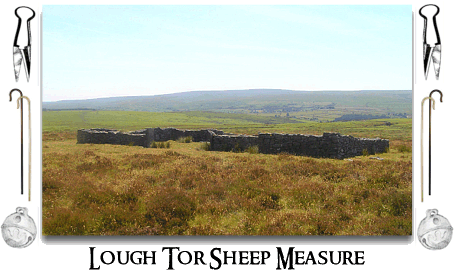
Sheep Leaps are found usually on leats and consist of two granite ‘platforms’, one on either bank, which protrude partway across the width of the flow. The purpose of these was to assist sheep in jumping across the water. In other words one acted as a launch pad and the other a landing ramp. Some excellent examples can be seen along the Devonport Leat especially between Ockery Bridge and Tor Royal.
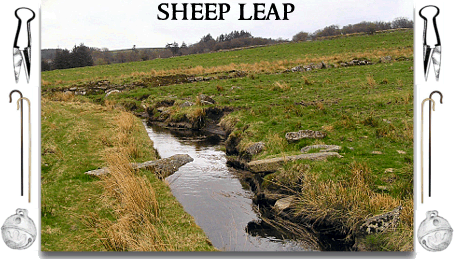
Another feature that one often comes across is the ‘sheep creep’ which is literally a purposefully constructed gap in the base of a wall commonly topped with a granite lintel. The idea was that the gap would allow sheep to pass from field to field but its deliberate size was too small for cattle or ponies to do likewise.
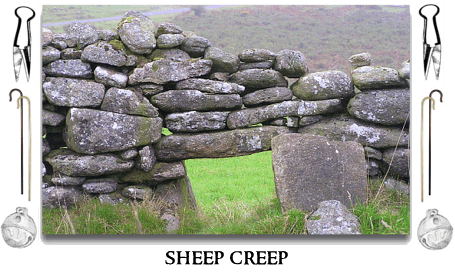
Once the sheep had been shorn its fleece would be rolled up and placed in a large sack. In order to establish the weight of the fleeces clearly they had to be weighed. As granite is abundant on the moor it was therefore only natural to make the scale weights from it. So to this day it is possible to see fine examples of granite weights on and around the moor.
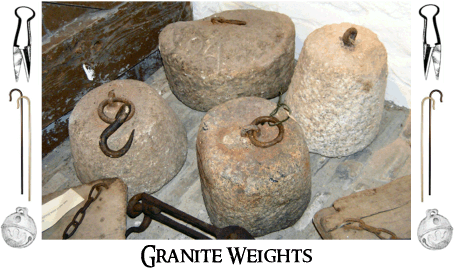
Photograph courtesy of the Okehampton Museum of Dartmoor Life.
It has always been said that all sheep want to do is, “die for living”, and believe me that certainly is true and it’s what puts bread on my table. Lice, ticks, scab, intestinal worms of all shapes and sizes, foot rot, braxy, tetanus, pulpy kidney, blackleg, lamb dysentery, black disease, pasteurella, and a whole host of deficiencies all prey on the poor sheep. Today, with good management and the correct use of vaccines, anthelmintics and supplements it is possible to keep them under control but go back a hundred years and these products weren’t available. It was a more ‘belt and braces’ approach with shepherds using a plethora of ‘cure alls’ and secret potions. Today if you want to get a liquid down a sheep or cows throat you use a modern automatic drenching gun which is simply attached to a bottle containing the treatment and then administered via a small nozzle inserted in the back of the mouth. A squeeze of the handle then draws another dose into the barrel and the next animal can be dosed. At one time all oral medicines had to be individually administered by a drenching horn, which was literally a hollow ox horn.
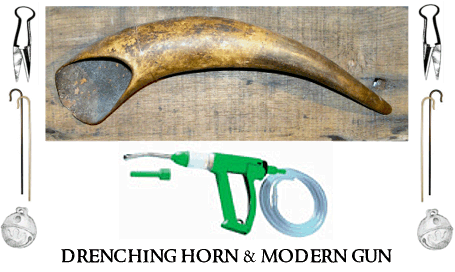
Photograph of Drench Horn courtesy of the Okehampton Museum of Dartmoor Life.
The very reason any oral treatment was called a ‘drench’ was that many of the early medicines were basically lethal and had to be well diluted, this resulted in a massive dose which was literally poured or ‘drenched’ down the animals throat. If you were to dose a lamb for worms today you would administer about 2.5ml/10kg of wormer, one hundred years ago you would probably pour about 560ml down through the horn. Scab was always a problem, in fact in recent years it still is and to prevent this virulent disease the old shepherds armoury consisted of tar and pitch which was applied to the synonymous open sores. Some shepherds would also use a mixture of boiled suet, brine, chopped broom flowers and urine applied in the same way as the pitch. Today you simply, (well thanks to DEFRA its not quite so simple) plunge them in a sheep dip twice a year, not only does this control scab but also lice, ticks and flystrike. Flystrike was always a problem, this is when the Blue Bottle flies lay their eggs around the shitty backsides of the sheep. When conditions are right the maggots emerge and start devouring the sheep’s flesh, ugh tis a horrible and sight and honks like hell. Years ago the farmers had to ‘dag’ or clip the dung caked wool away with hand shears and then once again dress the wounds with tar. Today many of the dips and pour-ons control this problem admirably.
There are numerous other aspects about Dartmoor sheep that would easily fill a book, but tiny aside was the small sheep’s or crotal bell which I found in a field outside Ashburton. These would be used in many ways but their main function was to allow the sheep to be located, especially in snow or mist. Some shepherds would put them on the rams to warn of an unseen ‘horny’ charge from behind. Usually, a few of the more dominant sheep would have the bells attached as in most cases the rest of the flock would never be far away from them, clearly it would be too expensive to put a bell on every animal. They were often given or kept as lucky objects and sometimes would be given as a small wedding token.
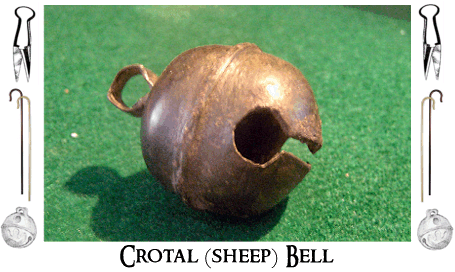
 Legendary Dartmoor The many aspects past and present of Dartmoor
Legendary Dartmoor The many aspects past and present of Dartmoor

Lovely and informative article, well written and descriptive. I wanted to find out what predates upon the moorland sheep as many a time I’ve come across the bony remains surrounded by wool. I presume most would have fallen victim to disease or old age and then stripped by foxes, crows and birds of prey. I’d quite like to think of a wild beast roaming the moor but that just appeals to my ” romantic” view of Dartmoor!